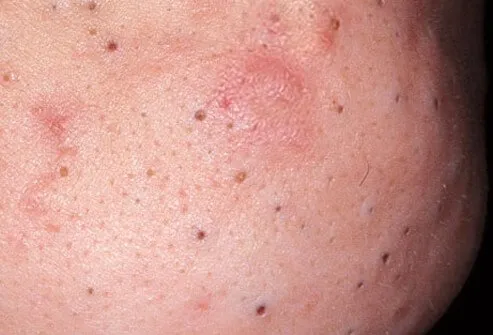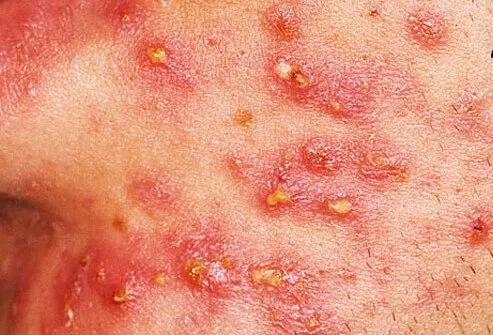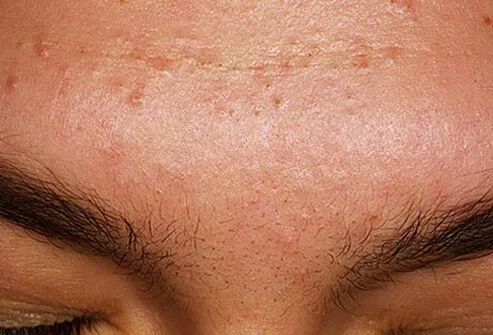What Causes Acne?

Acne vulgaris is the world's most common skin disease. Anyone of any age can get it, but teens and young adults are most likely to suffer acne outbreaks. In fact, 80 percent of people ages 11-30 have acne outbreaks at least occasionally.
To understand acne, you must start with human hair. Hair shafts cover the human body and are everywhere except the palms of the hands and the soles of the feet. Some hair is visible, and some is very fine and nearly invisible. Each follicle is embedded in the skin with an oil gland called a sebaceous gland.
Acne Starts at Puberty
Oil glands are small in children, but puberty (and testosterone in particular) causes these glands to grow larger. They secrete oil and cellular debris in a substance called sebum. Sebum keeps the skin flexible and acts as a protective barrier against water evaporation on the skin's surface. It also keeps hair shiny and soft.
Acne and Clogged Pores
Sometimes skin cells clog up these follicles, also known as pores. With the pores clogged, sebum gets trapped inside. Skin bacteria called Propionibacterium acnes (P. acnes) starts to grow inside the pores, too. The bacteria cause inflammation. When the clogged pore bursts open, all the sebum and P. acnes bacteria spill onto the surface of the skin, causing breakouts.
Comedones: Blackheads and Whiteheads

Comedones are clogged pores that fill with sebum (oil and cellular debris). Comedones can be either blackheads or whiteheads depending on how deep they are in the pores and how long they've been exposed to air. Comedones are the first step toward pimples.
The word "comedo" was coined in the late 1800s. It is based on a similar word for parasitic worms, which apparently bare some resemblance to the comedo within a clogged pore.
Products Can Cause Blackheads and Whiteheads
Products that may trigger comedones are called "comedogenic." Makeup labeled "noncomedogenic" is less likely to clog pores and contribute to acne.
What Are Blackheads?

Blackheads appear on the skin as tiny black dots. The dark color of blackheads is not caused by dirt; instead, this is the color sebum takes after being exposed to air. Blackheads also stretch the opening of a pore.
Blackheads are sometimes called open comedones.
What Are Whiteheads? Nose, Chin, Face

Whiteheads are small, raised bumps on the surface of the skin, and they are another form of clogged pore (comedo) that can be a precursor to pimples. Similar to blackheads, whiteheads form when the hair follicle fills with sebum. Unlike blackheads, whiteheads haven't pushed all the way through to the skin's surface, so they are considered closed off from air that turns the sebum dark or black.
Whiteheads are sometimes called closed comedones. They often appear on the face, especially the chin and nose.
Papules (Pimples)

Don't Pop Your Pimple
This type of pimple may be sensitive to the touch. Picking or squeezing can make the inflammation worse and may lead to scarring.
Papular Acne
One form of acne is called "papular acne." That's acne that has more papules than pustules (more on pustules in the next slide). Papular acne is common in people with course/oily skin.
Pustules (Pimples)

Pustules are another kind of inflamed pimple. They resemble a whitehead with a red ring around the bump. The bump is typically filled with white or yellow pus.
How are Pustules Formed?
Pustules are inflamed pores filled with the P. acnes bacteria. These lesions are what people typically think of when they think of pimples. The bacteria attract the body's natural infection-fighting cells, which cause the irritation and redness associated with pimples.
Pustules eventually burst open, releasing all of that oily sebum and bacteria. When they do burst, the bacterial substance causes more inflammation.
Pustules can form anywhere, but they are most common on the
- face,
- back,
- shoulders,
- breastbone area, and
- sweaty areas like the armpit and groin.
Don't Pop Your Pustule
Avoid picking or squeezing pustules. Picking can cause scars or dark spots to develop on the skin.
Nodules: The Bigger, Deeper Papules

Nodules are forms of papules, but they are bigger, and they form more deeply in the skin. These are large, inflamed bumps that feel firm to the touch.
Nodules develop deep within the skin and are often painful. Nodules should be treated by a dermatologist. Over-the-counter treatments may not be powerful enough to clear them up, but prescription drugs can be effective.
Cysts: Making a Diagnosis

Like nodules, cysts are a more extreme lesion that can result from acne. Also, like nodules, cysts can be very painful and should be treated by a dermatologist.
Acne cysts are closed pockets of tissue filled with pus. They resemble boils. Surgeons can drain or remove cysts.
People with nodules and cysts are usually considered to have more extreme forms of acne. These lesions are more common in men than in women. Cystic acne requires special treatment, and will be discussed later in this article.
Mild Acne

Acne falls into the "mild" category if you have
- fewer than 20 whiteheads or blackheads,
- fewer than 15 inflamed bumps, or
- fewer than 30 total lesions.
Mild acne is usually treated with over-the-counter topical medicine or self-care. It may take up to eight weeks to see a significant improvement.
Self Care for Mild Acne
While more severe cases of acne may require either topical or systemic medicine, mild acne symptoms can often be improved by practicing good daily self-care.
Here are some tips to ease your symptoms of mild acne:
- Gently wash your skin twice a day on the spot of the acne. Use a soap that is mild, and always use a clean washcloth. Work the soap in gently for a minute or two, and do not scrub. Rinse well.
- Anytime you work up a sweat, wash right after.
- Sometimes oils from hair can exacerbate acne, so wash your hair at least every other day.
- For men who shave: wrap a hot towel around your face before shaving to soften the hair, and always shave along your beard’s natural grain.
- Leave the acne alone. Don’t pop it, don’t squeeze it, don’t scratch it or poke it. Doing so can cause scars and infections.
- Avoid the sun and sunlamps, especially if you’re on antibiotics for acne.
- Choose makeup that is water-based (and oil-free!) Avoid oil-based creams and lotions, too.
Moderate Acne

Acne falls into the "moderate" category if you have
- 20 to 100 whiteheads or blackheads,
- 15 to 50 inflamed bumps, or
- 30 to 125 total lesions.
Dermatologists usually recommend prescription medication for moderate to severe acne. It may take several weeks to notice an improvement, and your acne may appear to get worse before it gets better.
Severe Cystic Acne

Severe cystic acne is a painful condition. Also called nodulocystic acne, people with severe cystic acne have:
- Multiple inflamed cysts and nodules.
- The acne may turn deep red or purple.
- It often leaves scars.
This type of acne is more common in men than women. When women do get cystic acne, they often experience outbreaks at certain intervals during their menstrual cycle, and often on the lower half of their face. Prompt treatment by a dermatologist can minimize scarring. In some cases, a doctor may inject corticosteroids directly into nodules and cysts to reduce the lesion's size, as well as painful inflammation.
Acne Conglobata

Acne conglobata is one of the most severe forms of acne. It involves many inflamed nodules that are connected under the skin to other nodules. It can affect the
- neck,
- chest,
- arms, and
- buttocks.
Characteristics of Acne Conglobata
The characteristic of acne conglobata include
- comedomes,
- pustules,
- foul-smelling cysts,
- sinus tracts, and
- atrophic and keloid scarring.
This type of acne is more common in men and is sometimes caused by taking steroids or testosterone. If systemic symptoms like fever or arthritic symptoms develop in patients with acne conglobata, the disease is termed acne fulminans. Timely treatment by a dermatologist is essential.
Acne Mechanica

Have you ever noticed red or pink bumps after wearing tight-fitting athletic equipment? It may have been acne mechanica, a skin condition usually found beneath heavy protective equipment, and is often seen on football and hockey players. Acne mechanica is caused by a combination of factors, including
- heat,
- friction, and
- pressure against the skin.
Acne mechanica is sometimes called "sports-induced acne" because it occurs frequently in athletes. Preventive measures include wearing an absorbent material under sports equipment and showering immediately after activity.
How to Get Rid of Acne: Topical Therapy

Topical therapy is acne medication that is applied directly to the skin, like gels or creams. Over-the-counter topical products can often help mild acne.
Topical medications may contain these ingredients:
- Benzoyl peroxide, which treats acne by unclogging skin pores and stopping bacterial growth. Some acne products with benzoyl peroxide include Brevoxyl and Triaz.
- Resorcinol, which dissolves whiteheads and blackheads. Resorcinol breaks down the upper layer of skin and helps remove dirt that may be trapped there. Acne products with resorcinol include Resinol and RA Acne.
- Salicylic acid works by easing the swelling and redness that comes with comedones. It also opens blocked pores, allowing pimples to shrink. Common products containing salicylic acid include Asepxia, Noxzema, and MediPlast.
- Sulfur is mildly antimicrobial antibicrobial, and it is used in acne products to prevent P. acnes growth. Sulfur also helps keep the surface of the skin dry of oils and actually helps peel off this layer of skin, which is already dead. Many acne-fighting medicines use sulfur, including Clearasil, the Proactiv Refining Mask, and Murad.
- Tretinoin works by affecting the growth of skin cells. Common acne-fighting medications with tretnoin include Retin-A, Atralin, Refissa, and Tretin-X.
Prescription products such as antimicrobial or retinoid creams can be used to treat mild to moderately severe acne. These can be prescribed alone or in combination with other ingredients.
How to Get Rid of Acne: Systemic Therapy

Systemic therapy refers to acne medication taken by mouth. Antibiotics may treat moderate to severe acne by targeting bacteria and reducing inflammation, and include medications like
- tetracycline,
- minocycline,
- doxycycline, and
- erythromycin.
Other systemic therapies include
- oral contraceptives, which can reduce acne in some women,
- spironolactone, an anti-androgen hormone pill, and
- isotretinoin (high-dose prescription vitamin A). Isotretinoin is used only in certain severe, cystic acne cases, or in cases where other treatments don't work. A course of isotretinoin treatment requires regular appointments with your dermatologist.
How to Get Rid of Acne: Medication, Best Treatment, Cystic Acne
This tool does not provide medical advice. See additional information: 
© 1996-2024 WebMD, LLC. All rights reserved.